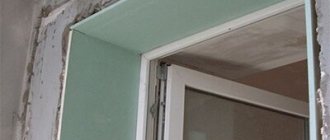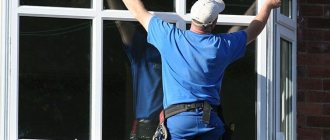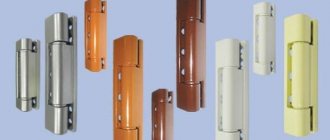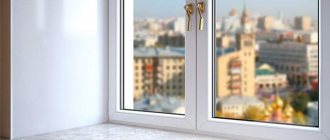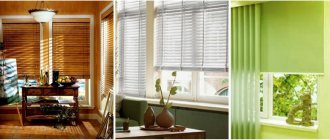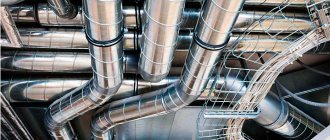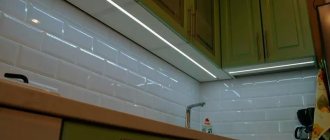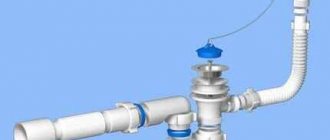A PVC window with double glazing is part of the enclosing structure of the outer wall.
When installing a translucent element, thermal technical requirements must be observed to achieve proper energy efficiency of the room.
The window frame must be installed in such a way that a dew point does not form in the room. To do this, the window is often hung above a layer of insulation in the wall. When organizing such a complex installation, anchor plates for PVC windows are required.
Fasteners for plastic windows - an overview of the necessary materials and fasteners for window installation
Any product needs to be securely fixed in its place. In the case of plastic windows, several products perform this role. There are several types of fasteners for plastic windows. The comfort of your indoor life will depend on the correct choice of quality materials. In order to choose the right fasteners, you can look at the photo of window fasteners.
What types of fasteners are there for plastic windows?
In order to fix window frames, a window or frame anchor is used. It can be easily distinguished from other clamps by the following characteristics:
- Threaded screw.
- Sleeve or metal shell.
- Inner sleeve.
It is used as follows: while screwing in the screw, the sleeve will paint the metal shell. This ensures reliable fixation of the mount.
The main disadvantage of this fastener is the inability to pull it back out. Thus, its advantage (reliable fixation) also becomes its disadvantage.
That is why, when using anchors as fasteners, it is necessary to immediately install the window frames correctly, so that later you do not have to redo all the installed products.
The length of the anchor can be one hundred to two hundred millimeters. Its thickness is from eight to ten millimeters. When choosing an anchor, it is necessary to take into account the distance of the slope to the window frame.
The anchor bolt must be attached to the inside of the frame. This DIY installation of fasteners for windows will be quite complicated.
Screws for concrete walls
A regular screw may be suitable for fixing a plastic window. Their great advantage over the anchor is considered to be simple dismantling (if necessary, of course).
In terms of technical characteristics, it is similar to an anchor boat - its length ranges from one hundred to two hundred millimeters, its diameter varies from eight to ten millimeters. The length of the screw should be exactly the same as the anchor screw.
The plastic window can be fixed using anchor plates. They are divided into those that can rotate and those that cannot.
Among the advantages of the anchor plate:
- Does not require additional through drilling of the frame, as is the case with an anchor bolt or concrete screws.
- If there is reinforcement in the wall, this in no way affects the fastening itself. The plate can be rotated.
- Such fasteners are used in difficult houses, which include buildings of the P-44 series.
The standard plate has the following dimensions - from one hundred to two hundred millimeters. Attach it to the outer edge of the plastic window.
When choosing fasteners for plastic windows, pay attention to the width of the PVC profile. Each manufacturer produces window frames with different profile widths
How to properly install plastic windows
A brick house is considered one of the warmest and most reliable. Unfortunately, it is quite difficult to install plastic windows in such houses. This is due to the fact that when using a frame dowel, it is necessary to make the necessary holes only on site, and not in advance. Otherwise, there is a risk that the anchor will not end up in the mortar that the builders place between the bricks.
The frame dowel must extend into the brick by at least six to ten centimeters. If the material is hollow, a two hundred and second anchor may be suitable.
Anchor plates can be used for fastening plastic windows in brick walls if there is complete confidence that the brick is not hollow
Unfortunately, sometimes construction companies sin by using solid bricks of poor quality. In this case, attaching the plate by non-professionals will be quite problematic. If you want to choose the most reliable fasteners, you can familiarize yourself with the catalog of galvanized fasteners.
How to fix windows in a wooden house
An anchor plate is considered an ideal option for fastening plastic windows in wooden houses. Their advantages include:
- Quick installation of plastic windows in wooden walls.
- Compensation for temperature expansions.
- Does not affect window connectors during house shrinkage.
Thus, the advantages of fasteners for wooden windows are immediately visible.
Aerated concrete and fastening of plastic windows
In order to secure window frames in loose concrete, it is necessary to use dowels with the maximum length. Otherwise, you can use anchor plates that are attached to special dowels.
It is up to you to decide which fasteners are best to choose for window installation, but it is recommended to consult with professionals who will take into account the specifics of your walls and the material of the window frames.
How to determine which ones are needed?
The choice of high-quality self-tapping screws largely determines the safe, long-term and comfortable operation of the window opening filling element.
Before purchasing self-tapping screws, you need to pay special attention to the following nuances :
Preliminary measurements of the parts to be connected to select hardware of the optimal length and diameter.- Selecting a self-tapping screw head. For moving elements of the sash, fastening elements with hidden heads are required, which form a single plane with the metal surface of the fittings.
- When attaching vertical and horizontal profile elements to each other, self-tapping screws with press washers or round heads are required to prevent pressing through the soft structure of the PVC product.
- All hardware must be made of high-strength steel; the jaws on the head must not wear off when tightened.
- The best solution would be to buy self-tapping screws with a galvanized coating, which prevents corrosion and destruction over time.
- The thread on the surface of the product must be uniform, without scoring, the tip of each self-tapping screw must be sharp, without bends.
If a consumer has doubts about the quality of a self-tapping screw at a retail outlet, it is recommended to purchase a small quantity to check its strength, and then order the bulk.
It should be noted that a self-tapping screw cannot cost less than the steel itself from which it is made. If the price for 1 kg of products is too low, such hardware is most likely made of low-quality material.
Installation process
The process of installing PVC windows in a wooden house requires strict adherence to technology. The first step is to carefully take all measurements. First determine the distance from the floor to the window sill. To do this, you will need to take into account the height of the person. Equate the resulting distance to 80 or 90 cm.
When taking measurements, it is necessary to take into account the comfortable distance to the window. The window sill should be higher than the dining table or desk. When everything has become clear with the location of the window sill, it’s worth moving on to inserting the openings
They will be 5 cm below the window sill. This distance must be ensured for polyurethane foam
When everything has become clear about the location of the window sill, it’s worth moving on to inserting the openings. They will be 5 cm below the window sill. This distance must be provided for the mounting foam.
Cut the opening using a level. Using a plumb line, mark vertical marks. The upper limit is determined taking into account the height of the structure. PVC frames suggest an increase in the opening by 14 cm above the window structure. The width of the opening should also be 12 cm larger than the frame.
When the preparation of the openings and casing is completed, you can proceed to the installation of double-glazed windows. In this case, it is worth considering one basic rule - you cannot drill through the frame, as this can break the tightness and thermal insulation. It is best to use special fasteners for this. Installation work can be simplified if you remove the sash from the frame. This makes it possible to lighten the design.
The frame installation process is carried out using a level. This will make it possible to get it to fit correctly. After installing the frame, you can proceed to fixing the slopes. At the same time, do not forget about the gaps for the polyurethane foam. When the frame is already installed, you can pick up a gun with polyurethane foam and walk it around the perimeter of the opening.
When installing PVC windows in a wooden house, you must take into account the following features:
- The PVC window tray must be positioned strictly horizontally. To level it, you must use plastic plates.
- The strength of the fastening when installing the window sill can be increased if notches are made on the sides of the frame. Their depth will be 8 mm.
- The window sill must be secured using self-tapping screws.
- Before directly installing a PVC window in the house, you need to secure the handle of the double-glazed window. If it is in a horizontal position, this indicates that the sash is open. To fix the handle, use the bolts. Then set it to the lower position.
- When the structure is fixed with self-tapping screws, a beam 1 cm wide should be placed between the window and the frame.
- When installing double-glazed windows, it is necessary to provide adjustment plates. They will be concentrated between the plums. This will allow for the necessary removal of condensate.
- The glass unit must enter freely. If the structure is skewed, cracks may occur in the glass.
- Upon completion of all work, it is necessary to take PVC glazing beads and secure the double-glazed window. Eliminate the space between the opening and the window using polyurethane foam. When it hardens, remove its excess, install drainage and platbands.
Why should you choose plastic products?
Plastic is the most common and versatile material.
Plastic slopes are most often installed
This is due to its performance characteristics and ease of installation. The advantages of plastic slopes include:
- Easy to care for the surface - just wipe the plastic with a cloth and soapy water;
- High-quality plastic does not fade when exposed to sunlight;
- Plastic looks best combined with the profile surface of plastic windows;
- The service life of these products is calculated in decades;
- For plastic slopes, when insulating them, you can use mineral wool. In this case, heat loss through the window structure is reduced and the effect of window fogging is eliminated;
- The moisture resistance of the plastic is obvious, so it does not collapse under the influence of condensation;
- Simple installation - the parts just need to be treated with adhesive and fixed to the surface of the base.
Installation
Plastic slopes can be glued in the traditional way - on polyurethane foam. This installation has some differences from that used for plasterboard slopes.
- At the initial stage, a starting profile is installed around the entire perimeter of the window opening . In order for the connection to have sufficient tightness, when attaching the profile, its back side is covered with a thin layer of silicone sealant;
First, the starting profile is fixed. Parts are cut out of sheet plastic 8 mm thick. The window is measured in the same way as when installing plasterboard parts;
A plastic part is cut to size. A frame made of bars is installed around the perimeter of the window;
A wooden block is installed around the perimeter of the window. A starting profile is attached to the wooden frame;
The starting profile is fixed to the wooden frame. The resulting parts are inserted into the U-shaped starting profile. First, a layer of polyurethane foam is applied in a wave-like manner to the entire plane of the base, thus completely filling the space between the block and the frame;
The gap between the block and the frame is foamed. The plastic elements are fixed with masking tape while drying.
After installing the slopes while the foam dries, they are fixed with tape
How to fasten plastic windows?
The choice of fasteners largely depends on the material from which the opening is made. We will consider below which fastening is most preferable for common types of buildings.
In a wooden or frame house
The best fasteners for plastic windows in wooden structures are anchor plates. The first and most compelling reason for this is the deformation processes to which wood is susceptible depending on changes in ambient temperature and humidity. This is especially true for log houses, even if the house has been allowed to stand.
If the block is fixed with self-tapping screws through the frame, there is a high probability of vertical shrinkage of the opening, which will cause the fasteners screwed into the lower and upper profile to be squeezed out. And it’s good if these are opening sections, since the beginning of extrusion will be visually noticeable. In blind blocks, the problem will only become apparent when the fasteners enter the glass unit.
Installation in frame structures should also be performed on plates. In some cases, the sidewalls of the structure are secured with self-tapping screws through the profile.
Video instruction:
Into concrete
Drilling high-quality concrete (lintels of window and door openings) with a ten-millimeter drill for an anchor is not an easy task. For such situations, it is better to use plates, which can be fixed using self-tapping screws for a 6mm dowel.
In conventional panel high-rise buildings, concrete is more amenable to drilling, and in most cases, anchoring does not cause any particular difficulties. Regarding the installation technical conditions mentioned above, there are a number of points that require special attention.
When glazing balconies or loggias, the structure must be placed almost flush with the outer part of the opening. Anchoring in such a situation is quite dangerous: the edge of the concrete floor or wall may be destroyed. Mounting to plates in such cases is the only correct option.
To the brick wall
Perhaps the simplest installation, but with some caveats. Unpleasant moments arise if the opening is partially destroyed or poor quality brick was used for masonry. In addition, drilling for an anchor in place can be complicated by the displacement of the drill when it hits a masonry joint. Therefore, it is necessary to clearly see the drilling location in order to make a hole in the middle of the brick.
Using plates makes installation a little easier because if a plate hits a seam, it can always be turned slightly. The quarter-snap anchor plates simply slide into a comfortable position.
Most often, installers combine the type of fastener: the sidewalls of blind sections can be safely fastened through the profile with self-tapping screws (6mm dowel and press washer of suitable length), sections with opening doors - a 10mm anchor. Top/bottom - either plates or no fasteners at all, only foam and spacers.
Combined fastening: top and bottom with plates, side with self-tapping screws for concrete
To aerated concrete
There are only two correct options for fastening to porous materials (foam concrete, aerated concrete and the like):
- Ten-millimeter anchor of maximum length (202 mm). The traditional method of fixation is through the profile.
- It is more preferable to fasten with anchor plates. The plate is attached to the profile as usual: either screwed with a screw or snapped into a groove. The other side is fixed with a regular self-tapping screw, but through a special dowel for aerated concrete. For successful installation in this way, you will need a hex key or bit to screw the dowel into the seat.
Besides these two methods, there is another one, but it is difficult to call it correct. Nevertheless, it is actively used by a certain category of installers. The fact is that foam concrete is a fairly loose material, and self-tapping screws can be screwed into it without drilling. This makes it tempting to fasten the blocks with screws without any dowels. Disadvantage: you cannot re-tighten the screw into the same place; low quality of fastening under axial loads on the screw.
Video instruction:
To metal structures
Depending on the design of the opening, the window is attached either to metal screws, or, which happens much less frequently, to anchor plates. The installation process depends on the thickness of the metal to which the block must be secured. A square pipe with a wall thickness of 2 mm, which is common on the construction market, is attached with a press washer and a drill through a pre-drilled profile. If the metal is thicker and a self-tapping drill is not enough for successful drilling, a hole in the opening will have to be made before tightening the press washer.
White crack sealant
You can also use sealant to seal holes from self-tapping screws. Today there are a huge number of them, but acrylic sealant is best suited for sealing cracks and holes.
To seal the cracks you need to do the following:
- First of all, the surface of the crack needs to be cleaned of all kinds of dirt, putty, and debris.
- Then the entire surface around the hole needs to be sealed with masking tape so as not to smudge it.
- After this, you need to take white acrylic sealant with a special syringe. Why do you need acrylic sealant? Because silicone cannot be painted if necessary.
- Next, the gap or hole is sealed using sealant. After applying the sealant, the surface must be leveled with a wet finger or cloth.
- Leave the sealant until completely dry. If necessary, the sealant can be painted.
Preparing the opening
When performing window installation work, you always have to devote some time to preparing and restoring the opening. This problem is especially relevant when replacing window units in old buildings due to extensive damage to dilapidated structures. In a good way, for a high-quality solution it takes two to three days, which is simply impossible in residential premises. Quick-hardening cement-based compounds and polyurethane foam in combination with sheet insulation come to the rescue.
After dismantling the old window, the opening must be freed from moving, crumbling particles and protruding elements of the old internal slopes. All surfaces are cleaned of dust, dirt, and oil stains. Loose areas should be secured by filling with a waterproof binder.
Large voids formed when replacing window blocks, for example, between rows of facing and load-bearing brickwork, are sealed with dense insulation, and all through holes are foamed.
In addition, it is necessary to remove sagging mortar, repair cavities and chips on the internal surfaces of the quarter that exceed 10 mm in height
Such attention to this section of the opening is explained by the fact that a hermetic tape seal will be placed here
What it is
An agreement is concluded with them, which states that the installation of plastic windows must be carried out in accordance with GOST.
Requirements and recommendations
If craftsmen are hired for the work, they install the products according to the standard. By law, all templates are respected. But often, each individual case is discussed.
To install
If a worker performs a procedure according to all the rules, then he must maintain appropriate documentation.
GOST for PVC windows 30971 talks about the following standards:
- filling the assembly seam;
- size of the gap between the profile and the opening;
- the dimensions of the opening itself;
- installation of the structure;
- general installation rules;
- correct maintenance of documents;
- guarantee.
When performing work, all of the above standards are observed.
To the window opening
According to the requirements, the window opening must be completely level. Most often, this is possible if the structures are installed in a new house.
Replacement may be difficult. The thing is that the opening transforms over time. It is affected by temperature, wind and other natural conditions.
During dismantling, you may find that the plaster has crumbled and the bricks have been chipped. In order to comply with all standards, it is necessary to prepare the opening for subsequent manipulations.
To the assembly seam
Its standards consist of two main rules. First of all, it must be resistant to external influences. The connecting part of the structure has its own characteristics: heat and sound insulation, water resistance.
According to standards, the seam is divided into three parts:
- interior;
- central;
- outer.
Finishing methods
There are several ways to tidy up your window. These may be the following options:
- Finishing with plaster. This method is quite old. Its main disadvantage is the complexity of the work. Plastering is time-consuming and requires careful cleaning of the area after finishing. When a house shrinks, it may crack.
- Application of drywall. This option is not bad, but it is only suitable for interior work. The room must be dry and warm, otherwise the sheet of drywall will begin to collapse.
- PVC profile for slopes is the best option. It is not afraid of moisture, temperature changes, is easy to install, and can be used both outside and indoors. This is an excellent solution for plastic windows, as it matches them perfectly in terms of material; the PVC F profile for slopes is very easy to install. It is quite possible to do this yourself. With other materials, for example, wood, the profile may not look so harmonious, although you can order wood lamination, and the differences will not be noticeable.
PVC profiles for slopes
Installation Basics
Now there are 2 methods of installing windows, which differ in the type of fastening unit and the method of fixing the frame to the window opening. This is installation with and without unpacking. To install a window yourself, it is wiser to choose the 2nd option, since it is simpler, does not require special skills, and the work does not take much time. In addition, it helps to avoid errors during installation and makes it quite easy to configure all the fittings.
Installation without unpacking does not imply removing the bead and dismantling the glass unit from the frame. The structure itself is attached to anchor plates. The principle of forming such fasteners is shown in Fig. 1.
Before installing a new window, you must select the correct plates themselves. They come in two types: universal and designed for a specific model. That is, they take into account the requirements of a specific profile system. As a rule, such anchor plates come complete with complex, non-standard structures.
Figure 2. Layout of anchor plates during installation.
Specialized fasteners differ from universal ones in that they are equipped with ears. These elements are installed in the groove of the frame profile and fixed with self-tapping screws. Universal plates do not have special ears. They are simply secured with bolts.
For the installation of window structures, experts recommend choosing bolts of the 4.5*25 type. Their body must be equipped with a metal drill. Since the self-tapping screw is attached to a reinforced structure, another type of fastening may not fit or will not fix the plate very securely.
Window installation rules
As a rule, it is recommended to install 5 anchor plates on a standard type window. Their location is shown in Fig. 2.
The central plate is fixed exactly in the middle of the frame, and the side plates are fixed approximately at a distance of 20-25 cm from the edge of the structure.
As mentioned above, the method of installing a plastic window without unpacking does not require removing the glazing bead and the glass unit itself. This becomes possible due to the fact that the frame is fixed using anchor plates to the outside of the window opening. Otherwise, you have to form through fasteners.
Figure 3. Low tide installation diagram.
But you need to remember that large structures (with an area of more than 4 m2) should not be installed using plates. After all, such a mount may not withstand the weight of the window. In this case, it is wiser to use anchor dowels. For plastic double-glazed windows of small or medium size, plates will be the most rational method of fastening.
Not only large windows, but also doors are secured with dowels. Professionals believe that this installation method is the most reliable. But it has a number of significant disadvantages:
- Installation with unpacking is difficult even for specialists. Often, with this installation method, the glass unit breaks or cracks form on it.
- Installation on anchor bolts is almost impossible to do alone.
- Working with such fasteners requires experience and special skills.
- The work requires more effort and time.
If you prefer this installation option, then you need to purchase dowels measuring 10*132 mm. In addition, installing anchors requires a powerful hammer drill. Some modern stores that sell equipment for construction and repair provide rental services. Therefore, it is not necessary to buy an expensive device. But it’s easier to install the window on plates.
Installation features
For a window block, fastening with plates is the safest, and metal parts can be hidden during the finishing process.
But before you undertake independent installation, you will need to study the rules for working with anchor plates.
The rigidity of fixation with any metal strip is somewhat less than with anchors. If the window is blind, only plates are enough. When installing a large product with heavy sashes, uniform load compensation is necessary, so you will need to not only insert the part into the groove and snap it into place, but also secure it with a self-tapping screw, which should go deep into the frame profile. Fasteners on the sides are mounted at a distance of 25 cm from the corners, in the upper and lower parts, and at the top the connection is placed strictly in the middle
It is important to maintain an interval of no less than 50 cm and no more than 1 m between the plates. It is necessary to ensure the correct bending of the parts (only at an acute angle), which reduces horizontal displacement to a minimum and provides optimal rigidity to the connection. In the opening, you first need to drill a hole for the anchor dowel, and then place it so that the wide neck presses the metal strip to the surface of the opening. To fasten one part, take 1 or 2 dowels measuring 6–8 mm
Final fixation is achieved using a conical locking screw. Despite the fact that the connection is subsequently masked by finishing the slope or plaster, it is advisable to make recesses of up to 2 mm when preparing points for fixation - this will ensure that the plates are positioned flush with the surface of the opening.
Let's consider the algorithm for installing a window system using PVC products as an example.
It is necessary to free the window frame from the packaging film, then remove the sash from the hinges and install additional and connecting profiles.
An exact calculation is made at which points the fasteners will be mounted. The plates are inserted into the frame and placed in the opening. The location of the points is marked on the wall with chalk or pencil.
The frame should be covered inside and outside with mounting tape, vapor barrier and vapor permeable, to ensure waterproofing.
The toothed elements of the plate (“claws”) are inserted into the grooves on the profile at the required angle so that they fit snugly against the slope
Additionally, you can fasten the part using a special self-tapping screw. Keeping a distance of 20–25 cm from the anchor to the edge, screw all the plates around the perimeter of the opening.
It is important that there is a correct bend of the fastener in two places of contact: to the opening and to the frame. Each strip must be fixed with a self-tapping screw and screwed through a plastic nozzle into the reinforcing profile. The depth of the hole should be 10 mm greater than the length of the dowel. The frame is installed so that there are rigid seals under each section of the structure and in the corners
After this, the structure is fixed vertically using mounting wedges. Before finally firmly securing the parts, it is necessary to adjust the position of the block using a building level.
Final work - creating an assembly seam, moistening it with water using a spray bottle, thermal insulation with polyurethane foam. It is advisable not to allow its excess. To do this, you can use vapor barrier butyl tape or construction sealing mastic. At the end, the slopes are finished with a plaster mixture, facing stone-polymer tiles, and facade materials. If you choose between two methods of installing windows, in the absence of experience, professionals advise using plates.
When using anchor dowels, additional assistance will be needed, the process itself will take a lot of time, and there is always a risk that the glass may be damaged. In addition, you will need expensive equipment - a high-power hammer drill and special 10x132 mm dowels. If a PVC window is secured with bolts, its depressurization is possible; in addition, if you are unaware of the subtleties and improper installation, the geometry of the frame is disrupted and it stretches over time.
In the next video you will see the installation of PVC windows on anchor plates.
Supporting Consoles
They are made in the form of profile metal plates with holes, which are used for fastening the profile on one side and the anchor on the other. The use of supporting consoles allows the installation of large-format window structures with complex configurations and heavy weight.
Supporting consoles are used when installing large-sized window units
The material used to make the supporting consoles is coated with a layer of zinc, so they are resistant to moisture. An example of a single cantilever is a flat rod bolted to a wall. Its height can be adjusted.
Material selection
Currently, the market offers profiles made of plastic and metal. Plastic moldings are cheap, but not of high quality. It would simply be unreasonable to use them for serious tasks, so most often they are chosen as a decorative addition.
In general, if we talk about how PVC panel the panel is partially “placed” in the profile itself and is fixed there. Therefore, to ensure reliable fastening, preference should be given to metal molding, which can be steel or aluminum.
As a rule, metal elements are also treated with a special compound that can prevent rust.
If we talk about sheathing slats, they can also be made of wood, however, this material is quite capricious. Despite the cost savings, this design will not please the owners for long - the wood may begin to rot, be exposed to fungus or become moldy. Therefore, the choice is still made in favor of other materials.
READ Converting a welding inverter into an induction furnace
Types of fastenings for plastic windows
- anchors or frame dowels;
- dowels or screws for concrete;
- anchor plates.
Frame dowel
This type of fastener is professional and is characterized by high reliability. The frame dowel consists of 3 elements:
- threaded screw;
- outer sleeve;
- inner sleeve.
The screw is mounted as follows: the sleeve is inserted into the prepared hole, the screw is screwed into the sleeve. When screwed in, the sleeve expands the sleeve from the inside, securely fixing the anchor.
At the same time, the reliability of fastening is also a disadvantage. The screw is screwed in so tightly that it will be almost impossible to remove it without destroying part of the wall. Dismantling of connections may be required when replacing old window units with new ones or when correcting installation errors. Dismantling the anchor connection to adjust the structure vertically and horizontally is quite problematic.
It will not be easy to secure a window with frame dowels in a house where the base has a multi-layer structure. For example, in panel houses, the walls have a layer of heat-insulating material inside, into which it is not possible to screw an anchor. The screw will fall into the insulation and the spacer will not open.
The size of the anchor is selected depending on the size of the gap between the frame and the slope. Anchors with a diameter of up to 10 mm are suitable for installing plastic windows. The fastening element is installed on the inside of the block under the double-glazed window. Based on the fact that the frame thickness is 40 mm and the screw enters the wall the same amount, the minimum mounting length is 80 mm. If there is 2-3 cm between the slope and the frame, then you need an anchor 11 cm long, and if it is 6-7 cm, then you will need a length of 15-16 cm.
Screws for concrete
In everyday life they are called turboprops, dowels, and concrete screws. The features of this type of fastener include excellent holding forces, which allows them to be successfully used to secure plastic windows.
- fastenings are highly reliable in concrete, brick, monolith;
- connections can be disassembled to adjust or replace elements.
There is only one drawback: dowels cannot be used for installation on walls with a non-uniform structure. The screw will fall into the insulating material.
Anchor plates
They are considered the most modern way of fixing window blocks. This type of fastener was created taking into account seasonal temperature changes and the elasticity of the material. Anchor plates are the only type of fastener that can reliably hold a three-dimensional window in multi-layer walls.
These plates are available in two types:
Installation of the device is quite simple: one side of it is fixed to the end of the frame, and the other is screwed to the base with a regular screw 50-80 mm long.
Advantages of using anchor plates:
- The frame does not need to be drilled through, as happens when using dowels or dowels.
- Rotary models can be easily reoriented without drilling extra holes if during operation the drill hits a reinforcement rod.
- In a panel house or one built from “experimental” materials, the use of anchor plates is the only way to securely fix the window unit.
The disadvantages include the insufficient reliability of fasteners when using a small and narrow plastic dowel. This is actually not true. Installation of window blocks is carried out with the obligatory foaming of the gaps with construction foam. When hardened, it additionally fixes the window at a predetermined level.
Fasteners for PVC structures
Plastic structures are installed using anchors, self-tapping screws (in some cases with dowels) or anchor plates.
Anchors
This type of fastening is available in two versions: a classic anchor and an anchor for hollow materials.
- Classic anchor. Consists of an outer galvanized sleeve, a Phillips screw and a bushing. The principle of operation is as follows: initially the screw and part of the sleeve screwed onto it are inside the sleeve, which expands when the screw rotates in a certain direction, thus fixing the anchor in the seat. A regular anchor is great for fastening in dense materials (brick, concrete, cinder block).
- For hollow materials. In general, this anchor is similar to the classic one - the differences are in the design of the sleeve and the sleeve, which now does not expand the sleeve, but deforms, squeezing along the axis (deformation is possible thanks to special slots). When twisted, part of the anchor significantly increases in diameter, which allows it to be fixed in loose environments. In dense materials, such fasteners also hold up well.
The length of the dowels varies from 70 mm to 202 mm. The size suitable for installation is selected based on the thickness of the window profile (60mm), the installation gap between the frame and the opening (standard 2 cm), and the material from which the opening is made. An entry of 5-6 cm into brick or concrete is enough, therefore, in a normal situation, you will need a 152mm anchor.
Measurements for Quarter Windows
We measure the horizontal shortest distance between the quarters. Then you need to add one and a half centimeters on each side. This is the width of the finished window. Vertical measurements begin from the bottom of the opening, and to the beginning of the upper quarter. This is the actual height of the future window. The window sill and ebb are measured in the same way as the window sill and ebb measurements for windows without a quarter. You should end up with several numbers:
1. height of the future window;
2. width of the future window;
3. the length of your window sill;
4. the width of your window sill;
5. optimal ebb length;
6. optimal width of the ebb.
If your living space is not new, and you have not yet removed the old window, then the measurements are the same as for a new house. The only difference is that you replace the window opening with the outer measurements of the window frame.
Table of contents
There are two main types of screws used for DIY repairs - for wood and universal. Their main difference is in the thread pitch - “screws” for wood are characterized by a huge pitch (more rare application of thread turns).
There is a misconception that universal parts are just as good for wood, plywood and chipboard as special parts. Is it possible to use floor insulation on a balcony while others can be used cold? No, of course, it won’t be difficult to screw them into these materials, but how well they will stay there is a big question. The fact is that the “raw material” into which the screw is “immersed” must lie firmly in the grooves of the thread, and the structure of the wood will not allow it to fit perfectly into the narrow “grooves” of a universal screw.
Installing the window sill and slopes
The installation of wooden windows, like plastic ones, cannot be considered complete if the window sill is not installed. The window sill board snaps into place and is attached to the stand profile. If, during dismantling, voids are identified under the window, you can fill them with insulation, for example, rolled or tiled, and then install a window sill. To finalize the opening, you need to understand how to properly install the slopes. They can be plastered or assembled from sandwich panels made of expanded polystyrene foam. With the latter option, the panels are cut to size locally, taking into account the geometry of each slope. A U-shaped plastic profile, otherwise called a starting profile, is screwed to the frame close to the slopes. A panel is inserted into it. The voids foam. Foam is a polyurethane foam sealant that, due to its properties, requires a certain amount of time to fully expand and harden. Typically from 1 to 24 hours. Where they adjoin the wall, the sandwich panels are covered with a decorative profile, most often F-shaped.
Finishing without problems: we attach PVC panels to the wall and ceiling
Nowadays, finishing surfaces with plastic panels has become quite popular. Such repairs look quite presentable and do not require large expenses. However, not everyone knows how to attach PVC panels to walls and ceilings, and therefore everyone is trying to come up with their own way. In today's article we will talk about the rules for finishing with such material. We will try to understand as much as possible what is required to carry out the work, how complex they are and whether it is possible to complete them without having certain experience.
